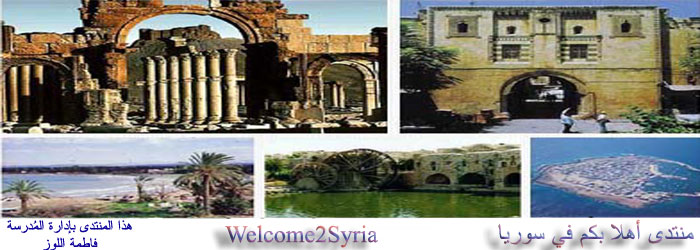LAND MARKS OF OLD DAMASCUS

 This great Mosque stands at the heart of the Old City at the end of Souq al-Hamidiyeh.It was built by the Omayyad Caliph al-Walid ibn Abdul Malek in 705 A.D. when Damascus was the capital of the Arab Islamic Empire.
This great Mosque stands at the heart of the Old City at the end of Souq al-Hamidiyeh.It was built by the Omayyad Caliph al-Walid ibn Abdul Malek in 705 A.D. when Damascus was the capital of the Arab Islamic Empire.
When al-Walid decided to erect an impressive mosque suited to the grandeur of the Arab state 'whose like was never built before, nor will ever be built after' as he is reported to have said, he negotiated with the Christian community of Damascus, and undertook to construct a new church for them (St.John's) and allot several pieces of land for other churches, if they relinquished their right to their part of the Mosque.They agreed.It took ten years and eleven million gold dinars, as well as a huge number of masons, artists, builders, carpenters, marble-layers, and painters to complete.It became an architectural model for hundreds of mosques throughout the Islamic world.
 This also stands at the heart of the Old City, on the southern side of the Omayyad Mosque, and very close to it.It is an astonishing example of a Damascene house, where the simple, almost primitive, exterior contrasts rather sharply with the beauty and sophistication of the interior.Here one finds a sense of space, a wealth of polychrome stone, splendid marble, cascading fountains, and fragrant flowers.The palace was built in the mid-eighteenth century for the Governor of Damascus.
This also stands at the heart of the Old City, on the southern side of the Omayyad Mosque, and very close to it.It is an astonishing example of a Damascene house, where the simple, almost primitive, exterior contrasts rather sharply with the beauty and sophistication of the interior.Here one finds a sense of space, a wealth of polychrome stone, splendid marble, cascading fountains, and fragrant flowers.The palace was built in the mid-eighteenth century for the Governor of Damascus.
 The old covered souqs of Damascus have a unique flavour you can savour with eyes closed.As you walk about in the warm darkness of these streets with their fragrant scents, spices, and colourful merchandise spilling out of the shops onto the pavements, you enter the strange world of exotic legends.Most prominent of these souqs are:
The old covered souqs of Damascus have a unique flavour you can savour with eyes closed.As you walk about in the warm darkness of these streets with their fragrant scents, spices, and colourful merchandise spilling out of the shops onto the pavements, you enter the strange world of exotic legends.Most prominent of these souqs are:
In the middle of this souq stands a bath (one of the two hundred public baths) which has been in continuous use from the twelfth century.
LANDMARKS OF THE NEW CITY
 The National Museum:
The National Museum:
The National Museum of Damascus is generally recognised as one of the finest of its kind in the world.Visitors can see artifacts of the great civilisations that emerged and flourished in Syria.There are thousands of statues, stamps, pieces of jewerelly, weapons, precious stones; sculpture, masks, tablets, textiles, mosaics, glass-work and earthenware, coins, and manuscripts from the ancient Syrian kingdoms of Ebla, Ugarit, Palmyra, Tel Sukas, Mari, Doura Europos, Bosra, Shahba and others.
An eighteenth-century building, which, like al-Azem Palace, is considered a fine example of old Damascene houses.It contains historical documents relating to the inhabitants of the city of Damascus.
It commemorates the memory of St.Paul, whose name was Saul of Tarsus, charged by the Roman to persecute the Christians.
Ref:
Historical Spots of Damascus - Visit Syria - Tourism in Syria ...

- The Walls and the Gates:
- The Ommayad Mosque
 This great Mosque stands at the heart of the Old City at the end of Souq al-Hamidiyeh.It was built by the Omayyad Caliph al-Walid ibn Abdul Malek in 705 A.D. when Damascus was the capital of the Arab Islamic Empire.
This great Mosque stands at the heart of the Old City at the end of Souq al-Hamidiyeh.It was built by the Omayyad Caliph al-Walid ibn Abdul Malek in 705 A.D. when Damascus was the capital of the Arab Islamic Empire.When al-Walid decided to erect an impressive mosque suited to the grandeur of the Arab state 'whose like was never built before, nor will ever be built after' as he is reported to have said, he negotiated with the Christian community of Damascus, and undertook to construct a new church for them (St.John's) and allot several pieces of land for other churches, if they relinquished their right to their part of the Mosque.They agreed.It took ten years and eleven million gold dinars, as well as a huge number of masons, artists, builders, carpenters, marble-layers, and painters to complete.It became an architectural model for hundreds of mosques throughout the Islamic world.
- The Azem Palace:
 This also stands at the heart of the Old City, on the southern side of the Omayyad Mosque, and very close to it.It is an astonishing example of a Damascene house, where the simple, almost primitive, exterior contrasts rather sharply with the beauty and sophistication of the interior.Here one finds a sense of space, a wealth of polychrome stone, splendid marble, cascading fountains, and fragrant flowers.The palace was built in the mid-eighteenth century for the Governor of Damascus.
This also stands at the heart of the Old City, on the southern side of the Omayyad Mosque, and very close to it.It is an astonishing example of a Damascene house, where the simple, almost primitive, exterior contrasts rather sharply with the beauty and sophistication of the interior.Here one finds a sense of space, a wealth of polychrome stone, splendid marble, cascading fountains, and fragrant flowers.The palace was built in the mid-eighteenth century for the Governor of Damascus.- The Damascus Citadel:
- The Souqs
 The old covered souqs of Damascus have a unique flavour you can savour with eyes closed.As you walk about in the warm darkness of these streets with their fragrant scents, spices, and colourful merchandise spilling out of the shops onto the pavements, you enter the strange world of exotic legends.Most prominent of these souqs are:
The old covered souqs of Damascus have a unique flavour you can savour with eyes closed.As you walk about in the warm darkness of these streets with their fragrant scents, spices, and colourful merchandise spilling out of the shops onto the pavements, you enter the strange world of exotic legends.Most prominent of these souqs are:- Souq Al Hamidiyeh :
 Souq Midhat Basha:
Souq Midhat Basha:
- Souq Al Harir:
- Souq Al Bzourieh:
In the middle of this souq stands a bath (one of the two hundred public baths) which has been in continuous use from the twelfth century.
LANDMARKS OF THE NEW CITY
 The National Museum:
The National Museum:The National Museum of Damascus is generally recognised as one of the finest of its kind in the world.Visitors can see artifacts of the great civilisations that emerged and flourished in Syria.There are thousands of statues, stamps, pieces of jewerelly, weapons, precious stones; sculpture, masks, tablets, textiles, mosaics, glass-work and earthenware, coins, and manuscripts from the ancient Syrian kingdoms of Ebla, Ugarit, Palmyra, Tel Sukas, Mari, Doura Europos, Bosra, Shahba and others.
- Al Takieh - Suleimanieh
- The City of Damascus Historical Museum:
An eighteenth-century building, which, like al-Azem Palace, is considered a fine example of old Damascene houses.It contains historical documents relating to the inhabitants of the city of Damascus.
- Al Salhieh:
- St Paul's Church
It commemorates the memory of St.Paul, whose name was Saul of Tarsus, charged by the Roman to persecute the Christians.
Ref:
Historical Spots of Damascus - Visit Syria - Tourism in Syria ...

